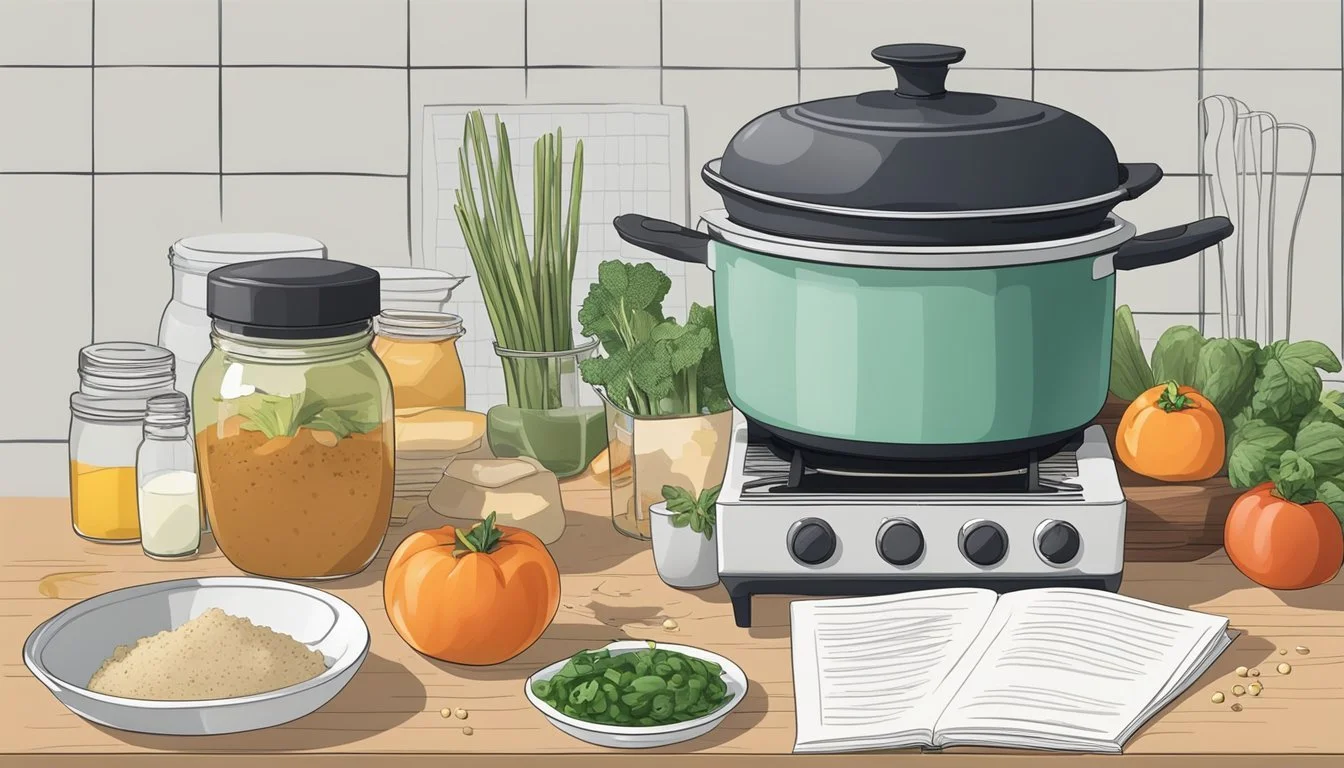How to Cook When You're Juggling Childcare
Efficient Strategies for Busy Parents
Balancing the demands of childcare with daily responsibilities can pose unique challenges, especially when it comes to meal preparation. Parents who juggle looking after their children and other tasks often find that the traditional approach to cooking, which may require focused time and attention, is not always feasible. Time management becomes essential, and finding ways to prepare meals that are both nourishing and convenient is a skill that can alleviate some of the stress associated with a busy schedule.
To navigate this conundrum, strategies such as meal planning, batch cooking, and utilizing time-saving kitchen appliances can be indispensable. They not only provide a way to maintain a balanced diet but also help to instill confidence in one's ability to successfully manage multiple tasks. Having a repertoire of quick, healthy recipes and being open to the use of frozen vegetables or pre-cooked proteins can also simplify the cooking process.
Moreover, flexibility is key. It's important for caregivers to adapt to the changing day-to-day circumstances that childcare brings. This might involve devising creative solutions when certain ingredients run out or tweaking routines to accommodate unexpected situations. By approaching cooking with a pragmatic and adaptable mindset, parents can find practical solutions to the challenges of preparing meals while also meeting the demands of childcare.
Understanding the Challenges of Cooking with Childcare
Cooking while managing childcare responsibilities requires juggling multiple tasks and maintaining a household routine that accommodates the needs of both the meal preparation and the children.
Balancing Parenting and Kitchen Duties
Parents often face the challenge of synchronizing their kitchen duties with their childcare schedule. Working parents must find time to cook that doesn't interfere with their professional responsibilities or the established family routine. Preparing meals requires significant attention, which can be difficult when children need supervision or assistance with their own activities.
Morning: Planning and prepping breakfast while ensuring children are ready for the day.
Evening: Cooking dinner with consideration for bath and bedtime routines.
The Impact of Family Dynamics on Meal Times
Family dynamics play a crucial role in how meal times are orchestrated. Meal times can be chaotic with varied schedules, dietary preferences, and the need for everyone’s attention to converge at the dining table. Families must consider the impact of each member's routine on the ability to eat together.
Parenthood: Adjusting meal preparations to suit both adult and child palates.
Family Attention: Ensuring that family members feel included and engaged during the meal.
Strategizing Your Cooking Approach
When juggling childcare, efficient meal preparation hinges on advance planning, maintaining clear communication with family members, and cultivating a community of support.
Advance Planning for Meals
Meal Planning: They should set aside time each week to decide on meals, ensuring a balance of nutrients and considering the preferences of all family members. A visual meal plan can be displayed on the refrigerator or a shared digital calendar.
Prepping Ingredients: They can wash, chop, and store ingredients in labeled containers. Batch cooking on weekends allows them to prepare multiple servings of a dish to be used throughout the week.
Effective Communication with Family Members
Assigning Tasks: They should clearly assign tasks to family members based on their ability. For example:
Family Member Tasks Partner Grating cheese, boiling pasta Older Children Setting the table, stirring ingredients Younger Children Washing vegetables under supervision
Discussing Preferences: They should engage in regular conversations about food preferences, which encourages family members to voice their choices and promotes a sense of inclusion.
Building a Supportive Community
Potluck Gatherings: They could organize potluck meals with friends or neighbors, where each family contributes a dish, spreading the effort and fostering community.
Cooking Rotations: Establishing a rotation system with a partner or trusted friends can lessen the daily cooking load, ensuring that they are not the sole individual responsible for meal preparation every day.
Mastering Time Management
Mastering time management is essential for parents juggling childcare and cooking. Effective scheduling and integration of cooking into daily routines can alleviate stress and create a harmonious balance between work and family life.
Creating a Practical Cook Schedule
Creating a cook schedule requires a realistic approach, acknowledging the varied demands of working parents. The first step is to inventory weekly time slots where cooking is feasible without interfering with childcare or work. Parents should designate specific days and times for meal prep that align with their family's routine. One can make use of cooking charts or digital calendars to plot out these time blocks.
Monday, Wednesday, Friday: Prep ingredients after bedtime (9:00 PM - 9:30 PM)
Tuesday, Thursday: Batch cook meals while kids do homework (5:30 PM - 6:30 PM)
Saturday/Sunday: Involve children in cooking for educational family time (11:00 AM - 1:00 PM)
Incorporating Cooking into Your Workday Routines
Working remotely presents a unique opportunity for parents to weave cooking into their workday routines. They can utilize breaks and downtime to manage quick cooking tasks. For those in the office, slow cooker recipes or pre-prepped meals can be timed to cook during the workday. The goal is to have meals ready when transitioning from work to childcare. Maintaining an organized to-do list can be helpful in tracking cooking activities while tackling work and childcare responsibilities.
Morning Break: Start a slow cooker meal (10:00 AM - 10:15 AM)
Lunch (What wine goes well with lunch?) Break: Prep ingredients for the evening meal (12:00 PM - 1:00 PM)
After Work: Finalize and serve a meal that has been prepped earlier (5:00 PM - 5:30 PM)
In conclusion, with thoughtful time management strategies, parents can efficiently handle cooking commitments alongside their childcare and work responsibilities.
Simplifying Cooking Processes
When juggling childcare, simplifying cooking processes is vital. Time-saving techniques and the effective use of kitchen appliances can make meal preparation more manageable and less time-consuming.
Utilizing Low-Effort Cooking Techniques
Low-effort cooking techniques are a godsend for busy caregivers. Slow cookers offer an excellent solution; one can simply add the ingredients in the morning and have a meal ready by dinner. The benefits of using low-effort techniques like braises or stews in a pot are twofold: they often result in tender, flavorful dishes and require minimal active supervision.
Batch Cooking: Preparing larger quantities of staples like rice or proteins can save a significant amount of time. These can then be used in different recipes throughout the week.
One-Pot Meals: Dishes that require a single pot reduce both cooking time and cleanup effort. This might include soups, casseroles, or pasta dishes.
Leveraging Technology and Appliances
Taking advantage of kitchen technology and appliances is essential to simplify the cooking process.
Slow Cookers & Pressure Cookers: These appliances can drastically cut down on active cooking time and still produce flavorful, nutrient-rich meals.
Rice Cookers: With the help of a rice cooker, one can achieve perfectly cooked grains with minimal effort, making it an ideal accompaniment for a variety of dishes.
Planning and practice are critical when leveraging technology to ensure meals are both easy to prepare and delicious. As one grows more skilled at using these appliances, they become an indispensable part of the routine, reducing time and effort in the kitchen.
Meal Planning and Prep Techniques
Effective meal planning and preparation help streamline the cooking process, especially when managing childcare. It ensures healthy meals are available despite a hectic schedule.
Weekly Meal Prep Strategies
Batch Cooking: Parents can dedicate a few hours each week to cook meals in bulk. They might prepare large quantities of versatile ingredients, such as brown rice or grilled chicken, that can be quickly incorporated into various dishes throughout the week.
Themed Meal Nights: Having themed nights, like "Meatless Monday" or "Taco Tuesday," simplifies decision-making and adds variety to the week's menu. This consistency helps in planning and can become a fun, family-friendly activity.
Individual Meal Containers: After cooking, they should divide the meals into individual portions. Parents find it convenient to store these containers in the refrigerator or freezer, which also aids in controlling portion sizes and reducing food waste.
Shopping and Ingredient Organization
Shopping Lists: Creating a shopping list aligned with the meal plan prevents impulse buys and ensures that parents purchase only what's needed. They can organize the list by sections of the grocery store to save time.
Ingredient Prep: Upon returning from the store, taking time to wash, chop, and store vegetables and fruits ensures that ingredients are ready to use. Marinating proteins ahead of time can infuse flavor and reduce cooking time later on.
Using Clear Storage Containers: They can use clear, labeled containers to organize ingredients in the pantry and refrigerator. This visibility reduces search time and helps track what’s in stock, thereby minimizing overbuying and spoilage.
Cooking for Multiple Meals
When cooking while juggling childcare, preparing multiple meals at once can save precious time and energy. One should focus on creating dishes that will serve well for dinner and the leftover elements that can be transformed for lunch or breakfast the next day.
Efficient Dinner Preparation
A strategic approach to dinner can streamline meal times. One could cook larger quantities to ensure that there are leftovers. They might also select recipes that require similar ingredients but yield different meals. For example, roasting a chicken can provide meat for a dinner of roast chicken and vegetables, with the remaining meat being used for chicken sandwiches or salads for lunch.
Batch Cooking: Cooking in large batches reduces the frequency of cooking sessions. They can make meals like lasagna or casseroles in bulk, and freeze portions for later.
Simultaneous Cooking: Utilize the oven space to cook multiple dishes at once. Here is a simple guide on how to arrange the baking sheets when cooking several items:
Position Item Top Rack Chicken Middle Roasted Veggies Bottom Casserole
Note: Ensure there is enough room between dishes to allow proper heat circulation.
Making the Most of Leftovers
Leftovers are not just repeat meals; they are components for new creations. They provide the base for a range of dishes that require minimal effort to prepare.
Transformations:
Dinner to Lunch: Leftover roasted veggies from dinner can become an omelet filling for breakfast or be tossed with quinoa for a healthy lunch.
Sides to Main Course: A side of grains or roasted seeds from dinner can become part of a main salad for lunch the next day, providing both texture and nutrition.
Separate Components: Store leftover elements like proteins, vegetables, and grains separately.
Airtight Containers: Use airtight containers to maintain freshness and avoid mixing flavors.
By cooking with a plan for multiple meals, one can not only make efficient use of their time but also provide their family with a variety of nutritious and enjoyable meals.
Incorporating Nutrition and Variety
Providing nutritious meals and a variety of foods helps ensure a balanced diet for children. It can also introduce them to new flavors, fostering a willingness to try different foods.
Designing a Diverse Weekly Menu
When planning a weekly menu, one must prioritize nutritional balance. This includes incorporating a range of fruits, vegetables, grains, proteins, and dairy. A table can help organize meal components and ensure variety:
Day Protein Grains Vegetables Fruits Dairy Monday Grilled chicken Brown rice Carrots Apple slices Yogurt Tuesday Lentil soup Whole wheat bread Spinach Banana Cheese Wednesday Baked fish Quinoa Broccoli Orange Milk Thursday Turkey and cheese wrap Pita Cucumber Grapes Cottage cheese (how long does cottage cheese last?) Friday Tofu stir-fry Rice noodles Bell peppers Pear Milk
Each recipe should cater not just to nutritional needs but also to the practicalities of cooking while managing childcare—simple yet healthy.
Involving Kids in Healthy Snack Choices
Involvement in snack selection empowers kids to make healthy choices. Presenting a variety of snack options in an accessible format encourages this behavior. For instance, a snack shelf within reach can display:
Fruits: Precut apples, bananas, or grapes in clear containers.
Vegetables: Baby carrots, cherry tomatoes, or cucumber slices, possibly with a healthy dip.
Proteins: Small servings of nuts (if age-appropriate), quartered hard-boiled eggs, or slices of cheese.
Grains: Whole-grain crackers or mini-muffins made from nutritious ingredients.
Children can select their desired snack, balancing their immediate preference with the availability of healthy options. Caregivers can guide them by pairing items from different food groups to ensure a balanced snack.
Self-Care While Managing Childcare
Taking care of oneself is a non-negotiable aspect of parenting—especially when balancing childcare demands. This section explores practical ways to address guilt and stress, and integrate exercise and personal care into a parent's routine.
Addressing Parental Guilt and Stress
Parents often experience guilt and stress when trying to allocate time for self-care. To combat parental guilt, they should acknowledge that self-care is not selfish but essential for their well-being and, by extension, for their child's well-being too. Creating a routine that includes short, regular breaks for restorative activities can help reduce stress levels. This could involve activities that they enjoy, such as reading a book or having a quiet cup of coffee, which can be integrated into their day without feeling like they are neglecting their child.
Acknowledge self-care necessity
Schedule regular, short breaks
Incorporate enjoyable activities
Finding Time for Exercise and Personal Care
Incorporating exercise into a busy schedule can seem daunting, but parents should view it as a crucial part of their self-care routine. One way to find time is to engage in physical activities that can be done at home or with children, such as dance parties, walks, or home workouts during naptime. Importantly, they should set realistic goals for their fitness to maintain motivation without becoming overwhelmed.
For personal care, parents can involve their children in their routines, turning it into a fun and educational experience. For instance, applying a face mask can become a mini science lesson about skincare. Also, simple activities such as deep breathing exercises can be practiced throughout the day to maintain calm and focus.
Engage in home or child-inclusive exercise
Set realistic fitness goals
Involve children in personal care routines
Practice deep breathing for immediate stress relief
Troubleshooting Common Cooking Challenges
When parents are balancing cooking duties with childcare, unexpected issues can arise and routines may be disrupted. This section provides targeted strategies for managing common setbacks and making necessary adjustments to ensure that meal preparation remains as smooth and efficient as possible.
Managing When Your Plan Goes Awry
Parents often face the challenge of a cooking plan not unfolding as expected, be it due to a child's unpredictable needs or kitchen mishaps. When things don't go to plan, it's important to have a flexible mindset and a prepared toolkit of solutions. Here are some practical tips:
Keep a well-stocked pantry: Ensure you have a variety of staple ingredients to pivot your meal plan if needed.
Prep in stages: Utilizing quiet moments, such as naptime or early mornings, can allow for greater efficiency.
Instant pot or slow cooker recipes: These can be life-savers when you need to step away at a moment's notice.
Learning from Mistakes and Adjusting Routines
Reflecting on cooking mistakes can be a valuable learning experience. By assessing what went wrong, one can adapt their cooking routines to be more resilient to the distractions and responsibilities that come with childcare. Key considerations include:
Document specific mistakes: Use a cooking journal to note issues and brainstorm solutions for next time.
Modify recipes for simplicity: Opt for recipes that are forgiving and require fewer steps or attention.
Adjust meal times: Align cooking schedules with children's routines, such as preparing dinner during their afternoon activities or after bedtime.
By mindfully recognizing and responding to these common challenges, parents can ease the stress of cooking while juggling childcare, allowing them to adjust their strategies in practical ways that cater to their unique family dynamics.
Closing Thoughts and Resources
As parents juggling childcare and cooking, the key is to approach meal preparation with efficiency and foresight. Strategies such as batch cooking, involving children in meal prep, and utilizing slow cookers can conserve energy and time. Resourcefulness in substituting ingredients and planning ahead with a weekly menu can turn the daunting task of cooking into a manageable part of daily routine.
Further Reading and Learning Opportunities
Luminous Early Childhood Learning Center: They offer workshops on time management and meal planning, which can be a great help for parents. Interested individuals can reach out via email to the center located in the Bronx for more information on their programs.
Curated Online Content: There's an abundance of blogs, websites, and online forums dedicated to parenting hacks. Parents can find recipes, timesaving tips, and advice on how to engage children in cooking activities from experts and peers.
Local Communities and Friends: Connecting with local parents through school networks or community events can lead to the exchange of childcare and cooking strategies. Friends who are in a similar situation can be valuable resources for support and idea-sharing.
Appendix
This section provides readers with tools to efficiently manage meal preparation alongside childcare duties by offering structured meal plans and essential contact information for childcare support services.
Sample Meal Schedules and Recipes
Monday to Friday Sample Meal Schedule
Time Meal Type Recipe Idea 7:00 AM Breakfast Oatmeal with sliced bananas 12:00 PM Lunch Turkey and cheese sandwich with carrots 3:30 PM Snack Yogurt and apple slices 6:00 PM Dinner Grilled chicken with steamed broccoli
Recipes:
Oatmeal with Sliced Bananas: Cook oatmeal according to package instructions, top with banana slices and a drizzle of honey.
Turkey and Cheese Sandwich: Layer turkey and cheese on whole wheat bread; add lettuce and tomato if desired.
Contact Information for Childcare Resources
Local Childcare Services:
Bright Start Childcare: (555) 123-4567
Happy Days Daycare: (555) 987-6543
Online Resources:
Care.com: A platform for finding local childcare providers.
ChildCare.gov: A federal resource for childcare assistance and information.
Acknowledgments
The guidance and strategies provided throughout this article are the culmination of contributions from various experts and experienced parents alike. The authors would like to express gratitude towards the cooking professionals at Epicurious for reinforcing the idea that slower cooking methods can be more manageable than seemingly quick meal preparations. Their insights on recipe ideas have proven invaluable for parents navigating the demands of social isolation and childcare.
Thanks are also extended to Luminous for highlighting the importance of strategic meal planning and the utility of roasted proteins that can serve as hassle-free meal centers. Their practical advice on managing nutrition with busy schedules has helped curate sensible cooking advice for working parents.
The article has further benefited from Productive Mama's insights on juggling work and childcare. The tips shared by this resource emphasized the need for communication with employers to seek flexible work arrangements, which directly affect meal preparation times and strategies.
Lastly, an acknowledgment is due to the Berkeley Parents Network, which shed light on the practical challenges faced when cooking with toddlers in tow. Their suggestions for quick, healthy, and toddler-compatible meals have significantly informed the recommendations made in this article.
Together, these sources have helped shape a resource that aims to empower parents with the knowledge to cook effectively while caring for their children.












